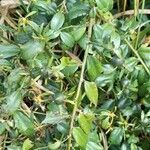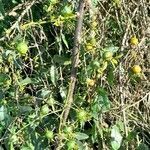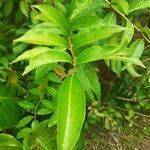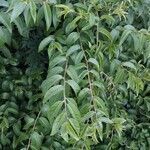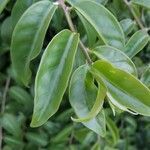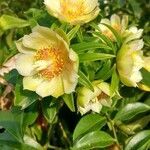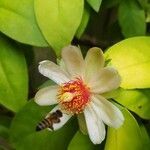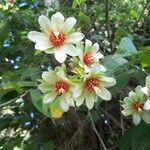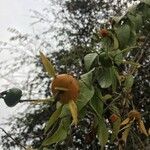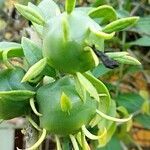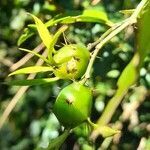Shrubs, at first erect, later clambering, 3-10 m tall. Areoles cushionlike and to 15 mm in diam. on trunk, 1.5-2 mm in diam. on twigs. Spines 1-3 per areole, on main branches acicular and straight, 1-4(-8) cm, on young branches additionally with 2 short, broadly based, recurved spines for climbing. Petiole 3-7 mm; leaf blade green or abaxially purplish, ovate, elliptic, or obovate, 4.5-7(-10) × 1.5-5 cm, glabrous, base cuneate to rounded, margin entire, apex shortly acuminate or acute; lateral veins 4-7. Flowers 3-4 cm in diam., fragrant (diosmin); pedicel 5-10 mm. Sepaloids pale green, ovate or obovate. Petaloids white to pale yellow, obovate to spatulate, 15-20 × 6-8 mm, margin entire, apex acute to truncate. Filaments white or golden, 5-7 mm; anthers yellow, 1-1.2 mm. Ovary superior; style white, 10-11 mm; stigmas 4-7, white, 3-4 mm. Fruit light yellow, obovoid or globose, 1-2 cm, spines eventually deciduous. Seeds 2-5, lenticular, 4.5-5 mm in diam., 1.4-1.6 mm thick.
Clambering shrubs or lianas; branches terete, relatively slender, about 3-10 m. long, with pairs of stout reflexed spines 2-5 mm. long. Leaves shortly petiolate, ,the blade variable, usually elliptic to obovate, obtuse to acuminate, the base obtuse to cuneate, 3-8 cm. long, 1.5-4.0 cm. broad, the petiole 3-5 mm. long. Flowers usually few or several in terminal or axillary panicles about twice as long as the subtending leaves; pedicels about 0.5-1.5 cm. long, accrescent in fruit; perianth white, yellowish, or pink, rotate, about 3-5 cm. in diameter, the segments rather numerous, the inner obovate-oblong, the outer oblong-linear; stamens numerous, less than half as long as the perianth segments; style rather stout, slightly longer than the stamens. Berry globose, 1.5-2.0 cm. in diameter, with inconspicuous thornless areoles, yellow or orange when ripe.
Shrubs or vines, clambering, 3-10 m. Stems to 3 cm diam., spiny; areoles to 15 mm diam., largest on basal portion of stem. Leaves lanceolate to ovate or oblong, 4.5-11 × 1.5-5 cm, 0.5-1 mm thick. Spines of 2 kinds; primary spines (= first formed) 2 per areole, recurved, clawlike, 4-8 mm; secondary spines to 25 per older areole, straight, 10-35 mm. Flowers to 70 in terminal or lateral inflorescences, fragrant, 3 × 2.5-5 cm; pedicels 5-15 mm; tepals perigynous; scales and areoles on prominent to inconspicuous tubercles; perianth whitish to light pink. Fruits yellow to orange, spheric, not angled, 40 × 15-25 mm, never proliferating. Seeds lenticular, 4.5-5 mm diam., glossy. 2n = 22.
Shrubby to clambering with long whip-like branches; areoles with 1-3 straight spines near the base of the plant but towards the top with pairs of short hooked spines in the leaf axils. Leaves shortly petiolate, oblong to ovate, 5-7 cm long, 3-4 cm broad, dark glossy green. Flowers aggregated towards the top of the branches, white, cream, yellow or pinkish, rotate, 2.5-4.5 cm in diam., with numerous spreading segments and stamens, strongly scented. Ovary beset with leafy scales, often spiny. Berry yellow, about 2 cm in diam., quite smooth when ripe; seeds black, somewhat flattened.
A large vine-like cactus. It is a woody climber. It can be 20 m tall. It has hooked spines on the stems. There are 2 forms of spines. The vine can be 9 m long and 5-8 cm wide. It is dark green. The leaves are fleshy. The leaves are oblong or sword shaped. Leaves are shed in the dry period. The flowers are 4 cm across. They are white but become cream or pink with age. They are waxy and lemon scented. The fruit are small and yellow with acid pulp. They are about 2 cm across. The flesh is white. The fruit are edible.
Climbing, stem-succulent shrub, 3.0-15.2 m high. Branches terete, green. Areoles with 1-3 charcoal-grey spines; paired hooked thorns present. Leaves oblong to ovate, up to 70 mm long. Flowers in panicles; bracts few, elongated, leaf-like. Sepals 4-7, greenish. Petals 7-12, white, apex obtuse. Stamens of mature flower oblique. Ovary dark green, surface with spines. Fruit yellow when ripe, ± 20 mm in diam., skin smooth. Seeds black.
Clambering or shrubby. Areoles with 1-3 straight spines near base of plant but towards top with pairs of short, hooked spines in leaf axils. Flowers white, cream, yellow or pinkish.
